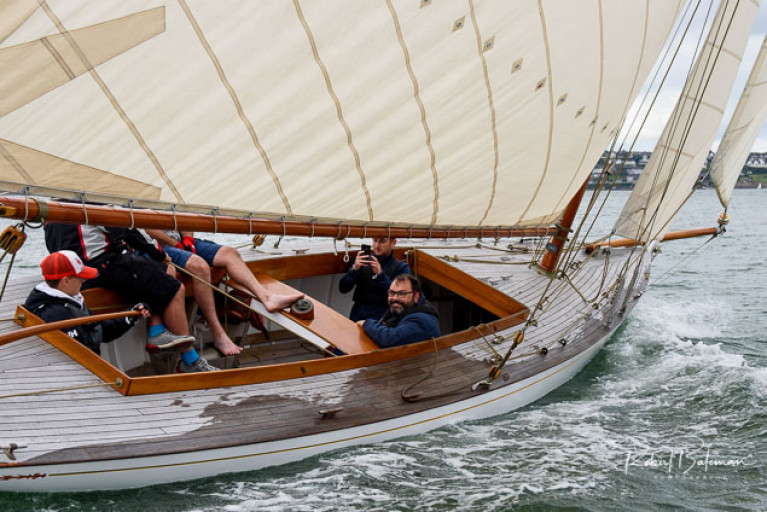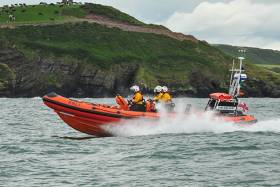Displaying items by tag: Cork Harbour
Royal Cork Yacht on Cork Harbour Rocks Is Refloated & Towed Safely Back to Crosshaven Boatyard
From a sad scene of what appeared to be nearly certain destruction for a racing yacht, a Cork Harbour Coastguard led team has successfully refloated the J/109 that grounded at the mouth of the harbour this afternoon.
As Afloat reported earlier, the Jelly Baby came to grief at Weavers Point during the final race of Royal Cork Yacht Club's Autumn League around noon.
After the yacht broached and hit rocks, all ten crew made it ashore safely, some climbing the harbour rocks to do so.
The grounded yacht stood on its keel at Bull Rock and was being pounded by the waves for several hours until the Coastguard and a salvage team could successfully get her off the rock and refloat her on a rising tide.
 Jelly Baby under tow back to Crosshaven
Jelly Baby under tow back to Crosshaven
 J109 Jelly Baby is hauled out at Crosshaven Boatyard with hull damage clearly visible following her afternoon on the rocks
J109 Jelly Baby is hauled out at Crosshaven Boatyard with hull damage clearly visible following her afternoon on the rocks
All crew are reported safe, but a top racing yacht of the Royal Cork Yacht Club is on the rocks at Cork Harbour after a Mayday emergency incident on the final day of racing in the Club's Autumn League.
After the race rounded a weather mark, the Class One yacht Jelly Baby broached, and it is understood that a crew member from the boat went overboard.
According to eyewitness accounts, the crewman was recovered safely by the ten strong J/109 crew, but the rescue manoeuvres, brought Jelly Baby close inshore and near the rocks at the harbour mouth.
Despite efforts to clear the lee shore, the yacht ended up on the rocks at Weaver's Point at a point known locally as Bull Rock.
Two crew went overboard. One was picked up by a competitor and the other by a RIB.
The incident led to to an emergency Mayday call responded to by the RNLI at Crosshaven and the local Coastguard Unit and the Port Of Cork Pilot launch.
 Coastguard attend the scene at Weaver's Point where a yacht went aground
Coastguard attend the scene at Weaver's Point where a yacht went aground
The rest of the crew made their way to safety by climbing the rocky cliff at Weaver's Point, an elevation of approximately 20 metres, at the mouth of Cork Harbour.

 The J109 yacht Jelly Baby at Weavers Point
The J109 yacht Jelly Baby at Weavers Point
Racing has been abandoned.
Coastguard Hopes to Refloat 'Jelly Baby' at high Water
 Coastguard volunteers attend the J109 Jelly Baby aground at Weaver's Point
Coastguard volunteers attend the J109 Jelly Baby aground at Weaver's Point
Update at 3.20 pm: The yacht remains aground and an attempt to re-float it will be made by the Crosshaven Coastguard team closer to high water.
The Coast Guard has set up a cordon near the boat.
Update: 6.30 pm: The yacht is successfully refloated. See vid here.


Cork Harbour One Design Jap Will Race in Cobh to Blackrock Yacht Race This Saturday
Royal Cork Yacht Club Admiral Colin Morehead was aboard Royal Cork's Jap for some pre-race preparations before next Saturday's big race from Cobh to Blackrock.
'She's So light, so responsive, an absolute joy to sail' was the verdict from the Admiral as the immaculately restored but engineless Cork Harbour One Design was put through its paces just south of Spike Island.
As Afloat previously reported the yacht that has been gifted to RCYC was originally built in Cork Harbour at Carrigaloe in 1897.
Jap is stored ashore by RCYC in its own special container and launching trailer. Plans are afoot to introduce more people to the historic craft over the course of the winter and next season.
See Bob Bateman's Jap photo slideshow below
Crosshaven RNLI Lifeboat Assist Anglers After Breakdown
Crosshaven RNLI Lifeboat in Cork Harbour was requested to launch yesterday evening at 9.45pm to reports of a speedboat broken down and adrift approximately one km south west of Trabolgan.
In calm conditions with a slight sea,the volunteer crew, under the command of Alan Venner with Ian Venner, Aoife Dinan and Vince Fleming on board headed to the area at best speed.
On arrival, the two anglers onboard the vessel had attempted remedial work with no results. The crew of the lifeboat then established a tow and landed the casualty at Crosshaven boatyard.
The lifeboat returned to station at 11.30pm and is currently being washed down and refuelled by the shore crew before being declared ready for service.

























































